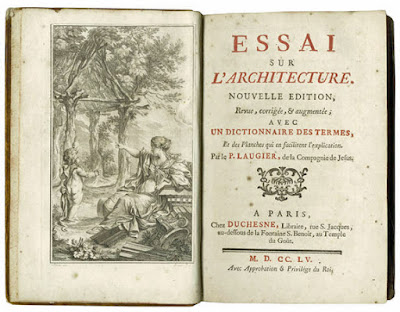the primitive hut
About The Primitive Hut in the history of art and architecture,
and why it means so much to us.
In the 1755 edition of the Essai sur l'Architecture, Abbe Marc-Antoine Laugier provides a drawing of the primitive hut. For Laugier, the primitive hut represents the first architectural idea. The hut is an abstract concept. While it is an imaginary "house", it has important meaning to us because it is an emblem of material construction, well-being and the art of dwelling.
The symbolic elements of Laugier's hut are simple: trees as columns. The tree-columns are rooted to the ground. They are alive. The foliage, although trimmed, provides a lush roof canopy. Simple, yet modern, it is a frame for living. The dweller fills in the rest.
frontispiece of the second edition of Essai sur l'Architecture (1755) by French artist, Charles Eisen.
In the drawing, Architecture, represented by a woman, leans upon the ruins of the classical orders. She points to the hut. A cherub, the embodiment of all that is ornate and capricious in art and architecture, looks to the hut in confusion, as if to say, "Am I to adorn that...really?" Architecture replies, "no, we are to uphold that: dwelling in nature, with nature and by nature."
The historian John Summerson wrote, "Marc-Antoine Laugier can perhaps be called the first modern architectural philosopher." Through Laugier's fable of the hut we have an enlightened nod to future sustainable construction, stylistic multiplicity, dwelling with nature, and individuality.
The historian John Summerson wrote, "Marc-Antoine Laugier can perhaps be called the first modern architectural philosopher." Through Laugier's fable of the hut we have an enlightened nod to future sustainable construction, stylistic multiplicity, dwelling with nature, and individuality.
“Different destinations give rise to more or less lofty ideas and call for a simple, elegant, noble, august, majestic, extraordinary or prodigious manner....Once the destination is known and the style (gout) chosen, the character of the building is fixed.” Laugier, Essai sur l'Architecture, 1753
Houses are living bodies, constructed of natural materials. Over decades, virgin wood petrifies and acts like stone. This is how a tiny house becomes a fortress. Even when synthetic or man-made materials are components in the overall construction of a house, nature plays upon them anyway. A house, like any structure must breathe or it will rot away. Not unlike a body with skin, a house is a filter of weather, time, use, history, occupation and nature. We may live in a big city surrounded by the densities of urban life or in a country field surrounded by the densities of local climate. Despite our locations, our homes, urban or rural, dwell in nature, with nature and by nature. The house is a body for living. It is a frame and filter for viewing life. It is simultaneously an inside and an outside. It is a human nature.


Comments
Post a Comment